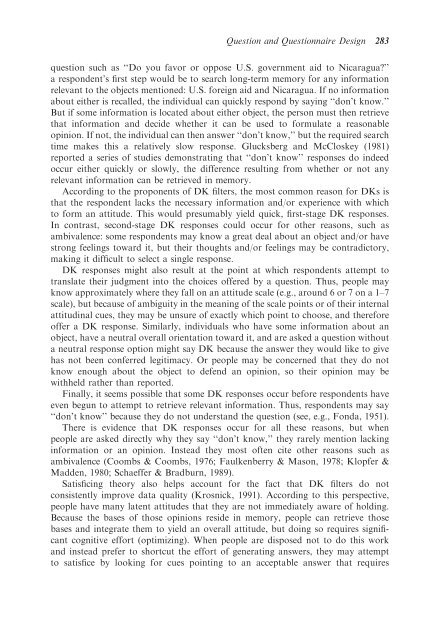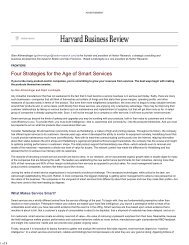Question and Questionnaire Design - Stanford University
Question and Questionnaire Design - Stanford University
Question and Questionnaire Design - Stanford University
You also want an ePaper? Increase the reach of your titles
YUMPU automatically turns print PDFs into web optimized ePapers that Google loves.
<strong>Question</strong> <strong>and</strong> <strong>Question</strong>naire <strong>Design</strong> 283question such as ‘‘Do you favor or oppose U.S. government aid to Nicaragua?’’a respondent’s first step would be to search long-term memory for any informationrelevant to the objects mentioned: U.S. foreign aid <strong>and</strong> Nicaragua. If no informationabout either is recalled, the individual can quickly respond by saying ‘‘don’t know.’’But if some information is located about either object, the person must then retrievethat information <strong>and</strong> decide whether it can be used to formulate a reasonableopinion. If not, the individual can then answer ‘‘don’t know,’’ but the required searchtime makes this a relatively slow response. Glucksberg <strong>and</strong> McCloskey (1981)reported a series of studies demonstrating that ‘‘don’t know’’ responses do indeedoccur either quickly or slowly, the difference resulting from whether or not anyrelevant information can be retrieved in memory.According to the proponents of DK filters, the most common reason for DKs isthat the respondent lacks the necessary information <strong>and</strong>/or experience with whichto form an attitude. This would presumably yield quick, first-stage DK responses.In contrast, second-stage DK responses could occur for other reasons, such asambivalence: some respondents may know a great deal about an object <strong>and</strong>/or havestrong feelings toward it, but their thoughts <strong>and</strong>/or feelings may be contradictory,making it difficult to select a single response.DK responses might also result at the point at which respondents attempt totranslate their judgment into the choices offered by a question. Thus, people mayknow approximately where they fall on an attitude scale (e.g., around 6 or 7 on a 1–7scale), but because of ambiguity in the meaning of the scale points or of their internalattitudinal cues, they may be unsure of exactly which point to choose, <strong>and</strong> thereforeoffer a DK response. Similarly, individuals who have some information about anobject, have a neutral overall orientation toward it, <strong>and</strong> are asked a question withouta neutral response option might say DK because the answer they would like to givehas not been conferred legitimacy. Or people may be concerned that they do notknow enough about the object to defend an opinion, so their opinion may bewithheld rather than reported.Finally, it seems possible that some DK responses occur before respondents haveeven begun to attempt to retrieve relevant information. Thus, respondents may say‘‘don’t know’’ because they do not underst<strong>and</strong> the question (see, e.g., Fonda, 1951).There is evidence that DK responses occur for all these reasons, but whenpeople are asked directly why they say ‘‘don’t know,’’ they rarely mention lackinginformation or an opinion. Instead they most often cite other reasons such asambivalence (Coombs & Coombs, 1976; Faulkenberry & Mason, 1978; Klopfer &Madden, 1980; Schaeffer & Bradburn, 1989).Satisficing theory also helps account for the fact that DK filters do notconsistently improve data quality (Krosnick, 1991). According to this perspective,people have many latent attitudes that they are not immediately aware of holding.Because the bases of those opinions reside in memory, people can retrieve thosebases <strong>and</strong> integrate them to yield an overall attitude, but doing so requires significantcognitive effort (optimizing). When people are disposed not to do this work<strong>and</strong> instead prefer to shortcut the effort of generating answers, they may attemptto satisfice by looking for cues pointing to an acceptable answer that requires
















